Here we are again: January, the start of a new year. The first month of so much more to come. It’s the perfect time to consider beginnings, starts, and firsts.
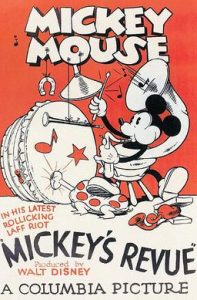 In 2021 and 2022, to kick off the New Year, I took a look at cartoon shorts that served as the first appearance of iconic animated characters.
In 2021 and 2022, to kick off the New Year, I took a look at cartoon shorts that served as the first appearance of iconic animated characters.
As animation history thankfully has, it’s provided us with an endless well of iconic animated characters. So, here is a return to that “well” to take another look back at how three more of the many classic animated characters we’ve come to know, and love, made their debut.
Each has evolved since their first appearance, and it’s always interesting or animation fans to see how they got their start.
Goofy, 1932, Mickey’s Revue (as Dippy Dawg), Disney
Goofy’s first time on screen could best be called a cameo, but it was a scene-stealing one. It’s no wonder that he soon made other appearances on screen.
In Mickey’s Revue, directed by Wilfred Jackson, Mickey and the gang, including Minnie, Pluto, and Horace Horsecollar, are putting on a show, and in the audience is an anthropomorphic dog. During the show, this dog annoys others in the audience, first by loudly chomping peanuts, then by constantly letting out a loud, bellowing laugh. Two goats sitting nearby decide to bonk the dog on the head with a mallet and then mock him by imitating his laugh.
This dog’s name was Dippy Dawg, and he would later become known as Goofy, a member of Disney’s “Fab Five,” along with Mickey and Minnie Mouse, Donald Duck, and Pluto, as one of the most iconic cartoon characters of all time.
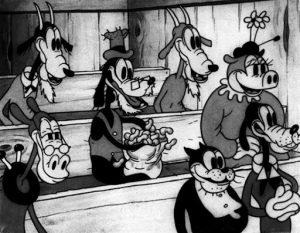 Even as Dippy Dawg, the character had several of Goofy’s traits, such as his hat and a laugh (provided by voice legend Pinto Colvig) that seemed an early version of his “Ah-Hyuck!” laugh that would become his trademark.
Even as Dippy Dawg, the character had several of Goofy’s traits, such as his hat and a laugh (provided by voice legend Pinto Colvig) that seemed an early version of his “Ah-Hyuck!” laugh that would become his trademark.
Where Goofy, as Dippy, differed here was that he appeared to have stubble, making him look older, and he came across as an annoyance rather than the clumsy, sympathetic, innocent character moviegoers would come to love.
The character’s first appearance made such an impression on Walt Disney and other artists that he continued to appear in cartoons as a supporting player, including The Band Concert (1935), Clock Cleaners (1937), and Lonesome Ghosts (1937). He would eventually adopt the name Goofy. The 1939 short Goofy and Wilbur marked his first sole starring role alongside his buddy, the grasshopper Wilbur.
Ninety-one years later, since first disrupting Mickey’s Revue, Goofy remains one of the pillars in the foundation of Disney’s history and a favorite of fans. As author John Grant, in his book, The Encyclopedia of Walt Disney’s Animated Characters: From Mickey Mouse to Aladdin, notes: “…we are all from time to time capable of demonstrating his distinctive brand of good-humoured folly, of bumbling when we try to excel. Every now and then, we are all Goofs. In Goofy we see ourselves reflected. That, maybe, is the ‘secret factor’ that makes the Goof so much loved by so many.”
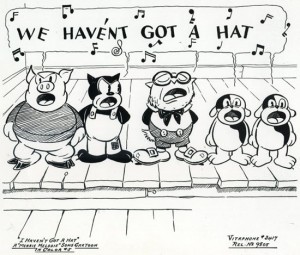 Porky Pig, 1935, I Haven’t Got a Hat, Warner Bros.
Porky Pig, 1935, I Haven’t Got a Hat, Warner Bros.
In this short, with “Supervision by Isadore Freleng,” we are introduced to a class of students presided over by Miss Cud, a cow. There is Beans, the cat, Oliver Owl, and Ham and Ex, two puppies. Also in the class is Porky Pig, who would become part of Warner Bros.’ legendary canon of cartoon stars alongside Bugs Bunny, Daffy Duck, and many others.
In I Haven’t Got a Hat, Miss Cud’s class has a recital, and each student performs. First up is none other than Porky, who recites “The Midnight Ride of Paul Revere” and “Charge of the Light Brigade,” while, of course, stuttering through it all (performed by actor Joe Dougherty, before Mel Blanc took over the role.).
The other students then perform their segments, which include Ham and Ex singing the title song, and as Jerry Beck and Will Friedwald note in the book Looney Tunes and Merrie Melodies: A Complete Illustrated Guide to Warner Bros. Cartoons:
“Still looking for a star, the studio here tries out a gang of kiddie characters; and who could have guessed that the one given the least attention (the pig and the opening act, in fact) would be the one to make it?”
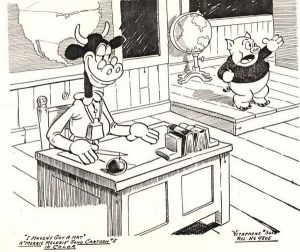 Porky’s appearance in I Haven’t Got a Hat is very dissimilar from what the character evolved into. In addition to a different design, he had more of a childish appearance, in keeping with the short’s setting, and sported a turtleneck sweater.
Porky’s appearance in I Haven’t Got a Hat is very dissimilar from what the character evolved into. In addition to a different design, he had more of a childish appearance, in keeping with the short’s setting, and sported a turtleneck sweater.
Also interesting is “That’s All Folks!,” which concluded classic Warner Bros cartoons, is uttered at the end of I Haven’t Got a Hat by a jester, with audiences, at the time, never guessing that the phrase would become ingrained as Porky’s catchphrase.
Including him in a number of shorts following this one, Porky’s design and overall persona would change from film to film. In the book That’s All Folks: The Art of Warner Bros. Animation, author Steve Schneider writes of how one of the studio’s artists finally helped define Porky:
“The character achieved his first coherent identity when Bob Clampett took over a ‘Looney Tunes’ unit in 1937. Clampett and his artists made Porky snappy and cute, downplayed his stammer, and cast him as an eager, if naive, delver into the world’s wonders.”
Mighty Mouse, 1942, The Mouse of Tomorrow (as Super Mouse), Terrytoons
Every superhero has their origin story, and Mighty Mouse is no different, as seen here in this short, directed by Eddie Donnelly, which takes place in a small village, where the cats terrorize the mice, waiting patiently in front of all the mouseholes.
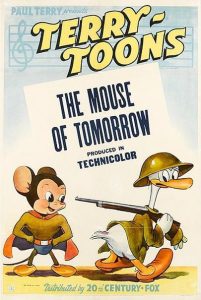 When the mice emerge all at once as the clock strikes one, the cats give chase, terrorizing the mice. One mouse escapes, burrowing his way through the wall of a supermarket. While inside, he cleans himself with “super soap” and eats “super soup,” “super celery,” and “super cheese,” and then, as the narrator informs us, “…behold! A Super Mouse!”
When the mice emerge all at once as the clock strikes one, the cats give chase, terrorizing the mice. One mouse escapes, burrowing his way through the wall of a supermarket. While inside, he cleans himself with “super soap” and eats “super soup,” “super celery,” and “super cheese,” and then, as the narrator informs us, “…behold! A Super Mouse!”
This Super Mouse, with his newfound powers of strength and flight, proceeds to defeat all the cats in the area, as the superhero is carried through town on the shoulders of the other mice.
A year later, Super Mouse’s name was changed to Mighty Mouse. In Of Mice and Magic: A History of American Animated Cartoons, author Leonard Maltin explained: “For years it has been assumed that the change came about because of legal action by the owners of Superman, but Bill Weiss [the studio’s longtime business manager] says that isn’t so. While the first cartoon was in preparation, a Terrytoons employee left the studio and took the idea with him. He went to work for a small publishing house and contributed his version of Super Mouse to a new comic book called Coo Coo Comics. The first issue appeared in October 1942, the same month that The Mouse of Tomorrow was released in theaters.”
To avoid confusion, Terrytoons changed the character’s name to Mighty Mouse (when shown later, The Mouse of Tomorrow re-dubbed the narrator’s voiceover to announce, “Mighty Mouse!” at the character’s appearance) and his initial look – scrawnier, with the blue and red, Superman-like colors – was changed in later cartoons to a bulkier character dressed in yellow and red.
Mighty Mouse would star in 80 theatrical shorts that were eventually featured in the popular Mighty Mouse Playhouse TV series, which debuted in 1955 on CBS. In 1979, Filmation brought the character back in new TV cartoons, and in 1987, Ralph Bakshi put his notable spin on Mighty Mouse.
But, in 1942, Mighty (then Super) Mouse’s greatest power was providing Terrytoons with a big screen hit.
There they are, from humble to history, the beginnings of three stars in our animated universe.


 Michael Lyons is a freelance writer, specializing in film, television, and pop culture. He is the author of the book, Drawn to Greatness: Disney’s Animation Renaissance, which chronicles the amazing growth at the Disney animation studio in the 1990s. In addition to Animation Scoop and Cartoon Research, he has contributed to Remind Magazine, Cinefantastique, Animation World Network and Disney Magazine. He also writes a blog, Screen Saver: A Retro Review of TV Shows and Movies of Yesteryear and his interviews with a number of animation legends have been featured in several volumes of the books, Walt’s People. You can visit Michael’s web site Words From Lyons at:
Michael Lyons is a freelance writer, specializing in film, television, and pop culture. He is the author of the book, Drawn to Greatness: Disney’s Animation Renaissance, which chronicles the amazing growth at the Disney animation studio in the 1990s. In addition to Animation Scoop and Cartoon Research, he has contributed to Remind Magazine, Cinefantastique, Animation World Network and Disney Magazine. He also writes a blog, Screen Saver: A Retro Review of TV Shows and Movies of Yesteryear and his interviews with a number of animation legends have been featured in several volumes of the books, Walt’s People. You can visit Michael’s web site Words From Lyons at: 






















If every superhero has an origin story, then Mighty Mouse is indeed different, because he has several. He was still living in the supermarket, and still known as Super Mouse, in his third cartoon, “He Dood It Again”. Although he would not be rechristened Mighty Mouse until his eighth cartoon, “The Wreck of the Hesperus”, “He Dood It Again” contains the following alliterative line of narration as a harbinger of things to come: “A powerful leap launches this mighty mouse on his mission of mercy.”
However, in his fourth cartoon, “Pandora’s Box”, Super Mouse is called into being from out of thin air when Pandora wishes for a boyfriend at a wishing well. Later, he gains superpowers by swallowing vitamin pills, specifically “Vitamin A, B, C, D, E, and XYZ.”
Then in his next cartoon, “Super Mouse Rides Again”, our hero comes to earth on a meteor, and from this point on he seems to have a celestial origin, living on a star or on the moon when he isn’t rescuing murine sopranos or vacationing in Miami Beach. In some of his adventures Mighty Mouse is a veritable deity, making his home on Mount Olympus or, as in “Eliza on the Ice”, up in Heaven with a coquettish Little Eva.
In “The Cat’s Tale”, Mighty Mouse is a foundling, left on the doorstep of a middle-aged mouse couple by a mysterious cloaked figure on a dark and stormy night. As in the story of Superman and the Kents, his superpowers are evident even in infancy.
There may be additional Mighty Mouse origin stories for all I know. I’m not all that familiar with the Filmation and Bakshi versions.
Since we’re on the subject of origins, does anyone know the origin of the term “the Fab Five” for Disney’s principal funny animal characters? Obviously it’s derived from the Beatles, which means it must have been coined well over three decades after the characters were created.
“I Haven’t Got a Hat” was probably the only 1933-1935 era WB cartoon worth watching for the fact Porky debuted in it.
Also interesting how little Friz Freleng would use Porky in his decades spent at WB, despite being behind the character’s creation. He even had Warren Foster as his writer for 8 years and only did 1 Porky-Daffy cartoon together (1952’s Cracked Quack, and they don’t even talk to each other in that one until Daffy’s response at the end).
I remember a collection of Disney stories from my childhood that included a short piece about Dippy Dawg trying to break in to Hollywood, and how his role in “Mickey’s Revue” was his big break, after which he changed his name to Goofy; someday when visiting my parents I need to look for that book again to refresh my memory, as the metafictional aspect of the story tickled my fancy even as a kid.
I’ve always like the title song from “I Haven’t Got a Hat”, even though (…well, okay, partly because) it was actually fairly dated even when it was first published; that probably contributed to its relative obscurity in ensuing years, apart from this cartoon and a couple of other Termite Terrace uses. Will Friedwald wrote an informative column about the song for this site a decade ago:
https://cartoonresearch.com/index.php/i-havent-got-a-hat/
Thanks for a fun annual series; I look forward to future coverage of “Picnic Panic” and its introduction of the immortal Molly Moo-Cow!
The 1955 Disneyland hour had an episode, “The Goofy Success Story”, which was included on the first DVD of “A Goofy Movie”. It seems to have a passing resemblance to that storybook version.
New animation showed desperate talent scouts (in scout uniforms) searching Hollywood for new stars. They hear Goofy laughing in the back of a cinema and bring him to a big studio. Some old shorts are shown as the movies Goofy is making, interlaced with new animation lightly spoofing Hollywood with a nod to James Mason in “A Star is Born”.
The new material is firmly set in the present with 50s-style design and an imaginary movie mogul in place of Uncle Walt, while the theatrical material is mostly pre-WWII. Safe to say they weren’t intending this to be “canon”.
That’s definitely the story I remember, thanks! My memory has conflated the book adaptation (mentioned below by Nic Kramer) with the scenes from “Mickey’s Revue”, but reading your summary of “The Goofy Success Story” jibes with what I remember of that childhood storybook. I don’t recall seeing that Disneyland episode on my copy of A Goofy Movie, but it has been quite a while since I’ve watched it; perhaps it’s time to revisit that low-key classic.
The book you are referring to was a Golden Book called “Goofy Movie Star”, a loose adaption of the Disneyland episode, “The Goofy Success Story”: https://goldenbookguy.com/product/goofy-movie-star-a/
Thanks for the link! The art style of that cover definitely matches what I remember, although my version was in a large hardcover collecting a number of Disney stories. I guess it shouldn’t be surprising that Disney found ways of repackaging and repurposing their output during this time.
The story was reprinted in the original 1962 edition of the Western Publishing compilation “Walt Diseny’s Storyland” (I have the 1987 soft cover edition which was still being issued in the ’90’s despite an updated edition was already out). When the updated 1991 version came out (which added the early Renaissances era animated features), “Goofy, Movie Star” was one of the storries that was dropped and replaced: https://disney.fandom.com/wiki/Walt_Disney%27s_Story_Land
Leonard Maltin was incorrect when he said “Coo-Coo Comics” was published by a “small publishing house.” That comic was published by Pines Publications, which was one of the largest publishers of pulp magazines at the time. The firm used multiple names (Better Publications, Pines, Standard Magazines, etc.,) but all the pulps can be identified by the words “A Thrilling Publication” on the cover. The company published many comics as well, including Terrytoons comics starting around 1956–titles included Mighty Mouse, Dinky, Little Roquefort, Gandy Goose, Heckle and Jeckle and the “Mighty Mouse Fun Club Magazine,” which promised “Games, Puzzles, Stories and Cutouts,”and had other Terry characters like Papa Terry Bear, Tom Terrific and even Gaston Le Crayon featured on the covers. It seems to me there’s some irony in the publisher of “Supermouse” comics later licensing Mighty Mouse and his friends from CBS. When pulps died, the chain morphed into the Popular Library line of paperbacks, which began as a sideline to the pulps and comics during World War II.
Pines also published the first five years of the “Dennis the Menace” comic book series, which many fans, myself included, consider the best run of the household hurricane’s nearly thirty year career on the spinner racks.
I read in J. B. Kaufman’s “Mickey” book that, even when “Mickey’s Revue” was in the story stage, the character was known internally as “The Goof”, indicating that the Disney staff was intending for him to be a new member of Mickey’s stock company.
As for Mighty Mouse, the Bakshi series did their own take on his origin story with “Mouse from Another House”. It was a more direct take on Superman’s story, in which Mighty was sent away in a rocket from an apartment building that was was being demolished, and then being found and raised by a squirrel couple.
In a way, it seems as if porky pig was Warner brothers version of Mickey Mouse. I say this, because porky pig was a kind of every man. You didn’t really know what age he was supposed to be at one time, and he would take on all kinds of tasks, whether being a kid in a classroom or, part of the US military! It is this aspect that makes the DVD set, “porky pig, 101“, so interesting!
Also, unlike the other Warner Bros. animal character stars, there was no organic reason for Porky to be a pig; he inhabited a human world, but never as pet (Sylvester was occasionally his pet) or prey (in Daffy’s debut, Porky was the predator).
I loved Mighty Mouse as a kid but sadly it doesn’t seem like his theatrical shorts, or any of his stuff besides the 80s series, is on DVD or blu-ray besides a couple public domain shorts. I’ve always wondered why with his popularity he hasn’t had sets released. Lost shows? Rights? Any knowledge on this? I’d love to own them one day alongside Mickey, Looney Tunes, etc.
I have a feeling you could talk to Jerry Beck all day about his efforts to get the MIGHTY MOUSE cartoons restored and out on video – which he has been trying to do for a LONG time!
I don’t get what the “hold-up” is, unless it would cost a LOT of money to get the cartoons restored? For me, the MIGHTY MOUSE cartoons are the best of the Terry-Toon product – bar none!
Tim – it’s because I get this question regularly I wrote special post to try to answer it. Click here to read it: https://cartoonresearch.com/index.php/lets-talk-terrytoons-why-we-dont-see-them-anymore/
Leonard – you know that old expression “it takes two to tango”? A lot of us want those Terrytoons we grew up with, Mighty Mouse in particular, to be available on physical media or even broadcast somewhere on terrestrial television. The sad answer – in my 30+ years of trying to make that happen – is that no one on the other end of that equation (in this case, Terrytoons current owner Paramount/Viacom) sees any further financial value to the property. To them it’s worthless kids fodder for some future children’s channel to mine. It will take a champion, a big name movie star or producer, who “gets it” to back a revival or mount a reboot. That said, I’m working on another angle to get these back on our screens – and I hope this year will yield some results. Cross your fingers. To be continued!
So you’re the one orchestrating David Zaslav to buy Paramount? –
Then George will have access to Terrytoons …
The secret is out –
You’re bouncing out Hippety Hopper in favor of a real mouse.
LOL. I’m not behind that – but I’m all in favor of it. And if that merger somehow happens, you can bet the Terrytoons would be a top priority .
Jerry: One of the things I like about you is that you are tenacious regarding products that you care about. As a member of the Official Popeye Fanclub (one word), I know that Fred Grandinetti’s “guerilla warfare” tacticts had a hand in getting the Fleischer and Famous POPEYE cartoons restored and out on DVD sets. But … YOU in particular (along with others) worked hard for decades to get these films out there. I would think that somebody at Warner’s and King Features Syndicate would HAVE to admit that, yes, they made quite a profit on getting those old POPEYE cartoons out to the public. I can’t see how the same thing – maybe on a smaller scale – wouldn’t happen again with the MIGHTY MOUSE cartoons! So, yeah … I’ll cross my fingers and – as my Austrian grandmother would say for good luck: “Squeeze the thumbernickel!” (Squeeze your thumbs!)
Leonard J. Kohl, like most everyone here I’d like to see Mighty Mouse and other Terrytoons on physical media. I console myself by watching the vast amount of those toons available on YouTube. It’s better than nothing.
Some years ago,I almost bought a set of MIGHTY MOUSE cartoons that were dubbed from a VHS set at a film “flea market” convention in either Chicago-land – or was it in Columbus, Ohio?. Apparently, they were from TV prints BEFORE CBS re-titled the main and end titles from the original 20th Century-Fox versions. The quality was a little “fuzzy” – but every so often, I think: “WHY didn’t I BUT this set?” There are a lot of us “old farts” who still remember the MIGHTY MOUSE cartoons with fondness. I suspect that a new generation of kids just MIGHT enjoy these too! Is it THAT EXPENSIVE to do a little restoration work and put them out?